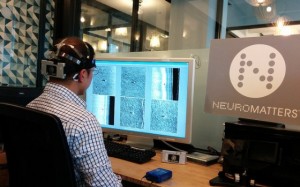 Underwater mines remain a concern for ships around the world. Mines still remain from World War II throughout the Mediterranean Sea, and in the Persian Gulf from Desert Storm and other recent military activities in that region. We developed techniques that combine computer vision with electroencephalogram (EEG) devices to enable the detection of mines in a much better and faster manner.
Underwater mines remain a concern for ships around the world. Mines still remain from World War II throughout the Mediterranean Sea, and in the Persian Gulf from Desert Storm and other recent military activities in that region. We developed techniques that combine computer vision with electroencephalogram (EEG) devices to enable the detection of mines in a much better and faster manner.
The current state of the art in mine detection has people scanning through large sonar images looking for the mines. This is a lot like “Where’s Waldo?”. Many objects look similar to mines, e.g., ripples in the sand. And it is even harder in some ways since the images are blurry and there is noise. Think about looking for Waldo with scratched and blurry glasses. We use computer vision algorithms to first detect potential locations of the mines, but they are not always accurate. These algorithms look for simple patterns, akin to looking for red and white stripes to find Waldo. But they can be tricked if similar patterns occur but they are not mines — just like the illustrators of “Where’s Waldo?” draw other objects with red and white stripes to fool the viewer. Thus, we give all of these potential mine locations from the computer vision algorithm to a human who can then verify if they are indeed mines or some object that looks like a mine. And since we prescreen these images, we can present them in a much faster manner to the human; we did it at 5 images per second by using EEG techniques.
This work was recently published in the Journal of Oceanographic Engineering, and was highlighted in the popular press (see links below). The authors are Chris, Alric, Paul DeGuzmann from Neuromatters, and Ryan.
Links:
Union-Tribune San Diego
ACM TechNews
GCN
UCSD News
UCSD Jacobs School of Engineering News
UCSD CSE News
Product Design and Development
Scientific Computing
ECN Magazine
R & D Magazine
Phys.org
EurekAlert